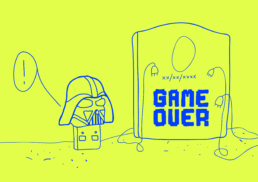In 1969, a few months after the hot summer that saw Man walk his first step on the Moon, the Karolinska Institutet entrusted Max Ludwig Henning Delbrück, Salvador Luria and Alfred Hershey with the Nobel prize for the discovery of the replication of viruses and their gene structure.
A few months later, in Houston, Texas, the first cardiac transplant was performed by Denton Cooley. An artificial heart was replaced to the patient’s heart in order to keep him alive until a new heart would be found. The artificial heart kept the patient alive for six-four hours.
A few months after the first surgical transplant, Robert Rayford died at the age of 16 from HIV/AIDS in the United States of America. He is the first victim to be certified for HIV/AIDS, but it will take twenty years to diagnose the cause of death and give a name to the disease of the twentieth century.
Meanwhile, the ancestor of the Internet was coming to light in some universities and laboratories in the United States, where a project was developed to connect a number of computers. The first node of this communication network was installed on the campus of the University of California Los Angeles. ARPANET was his name.
Fifty years later, after the cold winter of 2019 that saw the sprouting of cotton seeds on the lunar surface, thanks to the Chinese probe Chang’e-4, the first pediatric cardiac surgery operation was performed using a hologram, the second patient affected by HIV was treated by bone marrow transplantation, the Internet turned fifty years old and two American scientists named Robert Lanza and Robert Berman said: “There is no such thing as death, just a series of eternals now.”
The theme of death today awaits quantum physics, a branch of physics that studies the behavior of particles at the atomic and subatomic levels. Among the researchers most passionate about the issue there is Professor Lanza – scientific director at Advanced Cell Technology and assistant professor at the Wake Forest University School of Medicine – who supports the theory of Biocentrism, according to which death as we know it is nothing more than an illusion generated by our consciousness. This theory is based on the fact that it is life itself that creates the Universe and not the other way around.
In the work Biocentrism we can read about the experiment of the double slit, which is the basis of his statements. The experiment shows that when an observer watches a particle pass through two cracks in a barrier, the particle behaves like a bullet, passing through one of the two cracks. However, if the observer stops looking at the particle, it begins to behave like a wave, managing to pass through both slits at the same time. This means that matter and energy can present the characteristics of both waves and particles and that their behavior depends on the perception and consciousness of an observer. It is our consciousness, therefore, at the basis of reality. Realist philosophy from Ancient Greece to the present day has always affirmed that reality exists in itself, regardless of the existence of the observer.
Once space and time are accepted as constructs of our mind, it means that death, and the idea of mortality, are also a phenomenon linked to the sensory experience of our consciousness. With the death of our organism, our consciousness enters into a condition where there are no longer spatial and temporal boundaries, but the place of infinite possibilities: Eternity.
Owen Harris – director of the fourth episode of the third British series of Black Mirror – was probably fully aware of the double slit experiment the day he started thinking about the plot of the episode entitled San Junipero. It’s the 1980s and Yorkie, a shy and clumsy young woman, comes out for the first time in San Junipero and at Tucker’s she happens to meet Kelly, with whom she falls in love. Yorkie wants to see Kelly again and so begins to travel in times ranging from the 1980s to the 2000s, and the city takes on different aspects in the style of time soon you understand that the place is the virtual world of two elderly women. Kelly is an elderly woman with terminal cancer, while Yorkie is an over sixty-years-old quadriplegic, in a vegetative state since she was twenty years old. The two are elderly women are experimenting with the San Junipero program, which allows them to live for five hours a week in this virtual world. While they are alive, in fact, people can only access San Junipero for a few hours a week, but at the time of death they have the opportunity to ask for the definitive transfer of their consciousness, thus obtaining in fact eternal life. Yorkie dies and her conscience is permanently transferred to San Junipero. Kelly initially refuses by moral choice, but after much thought she decides to transfer her conscience to San Junipero, thus living with Yorkie an eternal youth. The episode ends with the image of a huge virtual cemetery. At TCKR system, the hypothesized neural research and technology company, a robotic arm arranges the capsules with the consciousnesses loaded into multiple usb sockets.
Now, let’s take the notes of Heaven is a Place on Earth by Belinda Carlisle, which concludes the aforementioned episode of Black Mirror, let’s mix them with the image of the molecules that travel in the slit, let’s add a pinch of statistics that attests that the world population is constantly growing and that the space in the cemeteries is getting smaller and smaller and here the image of a hypothetical cemetery is almost served. In the reader’s mind, I suppose, a very different design is created compared to that of the current cemeteries, of an anachronistic nineteenth-century model.
The ironic photograph of the 1982 film Amici miei II by Mario Monicelli, which portrays Professor Sassaroli and Paolo, widower of Adelina, in the silent Florentine cemetery of Porte Sante, is immediately remote, while the image of a previous film by Monicelli – Un borghese piccolo piccolo – in which a worried employee, masterfully interpreted by Alberto Sordi, wanders incredulously in search of a place for his dead son, appears if ever rather immediate.
A study published in America has made the count: conventional burials in the USA use 13 million kilograms of wood every year, equivalent to 1.6 million hectares of forest, a number of trees capable of subtracting 65 million tons of carbon dioxide per year, 2,700 tons of copper and bronze, 104 tons of steel and 1,636,000 tons of cement for the graves. Added to this is the fact that 53.3 million people die every year in the world, according to the World Health Organization. If each of them needs an average space of 1 meter by 2, this means 107,888.3 square kilometers of land for burials. Rome has an area of 1,285 square-kilometers, we could say almost ten times the surface of Rome!
For this reason, the first vertical cemeteries are beginning to develop, and they also exist in Italy, in Verona, but there are others in Oslo, Mexico City, Bombay and Paris. The tallest in the world is that of Santos in Brazil, a thirty-two-storey skyscraper that houses up to fourteen thousand dead.
It is easy to wonder, therefore, what will be the future building and ethical cemeteries!
What will be the physical dimension if the space for “apartments” in the city of the deceased is drastically reduced? And the problem of memory? Always the project Urnlights through the console Caronte – name not random! – leads us to listen to parts of the life of the deceased… Will this be the answer? Or, as in the project Capsula Mundi by Raoul Bretzel and Anna Citelli, will it be a capsule that from the ashes of our body will see the birth of a plant?
Will we still need a place born for the preservation of the body when Sandy Sullivan is experimenting with bio-incineration by alkaline solution? Or will the idea that the biological death of the body does not coincide with the death of consciousness be widely recognized and then it will only be necessary to worry about saving the consciousness on a virtual memory? At that point there will be a difference between the two worlds or they will be confused as it happens today with digital technology, smartphones and Iphones, physically one place, but perpetually in an “elsewhere.”
And the ethical problem? What will then be the ethical role of cemeteries when a group of researchers at the University of Yale, led by neuroscientist Nenad Sestan, have revived the brains of thirty-two pigs, about four hours after their slaughter?
If it is true that the smartphone is becoming an extension of our brain activity and the religion of the millennium, I wonder if the transition from the “city of the living” to the “city of the dead” will really exist for real or if the process will last in the future the time of a download, making the current technological experiments in funeral field already anachronistic before they spread.
I think back, to reassure myself, to the aphorism of Fernando Pessoa: “living is belonging to another. To die is to belong to another. To live and to die are the same thing.” I hope, perhaps out of habit, in a traditional burial.
Cemeteries and Biocentrism at San Junipero’s time © Francesca Vercellino
Reference List
- Berman, Bob; Lanza, Robert. 2015. Biocentrismo. L’universo, la coscienza. La nuova teoria del tutto. Milano: Il Saggiatore.
- Pessoa, Fernando. 1979. Una sola moltitudine, I. Edited by Antonio Tabucchi, and Josè Maria De Lancastre. Milano: Adelphi.
- Gamba, Enrico. 2017. “E se fossimo noi i creatori dell’Universo? Robert Lanza e il Biocentrismo,” (19 January 2017). https://www.enricogamba.org/psicologo-milano-blog/robert-lanza-e-il-biocentrismo
- La Bella, Cristina. 2019. “Cimiteri sempre più pieni, addio ai loculi: ecco cosa accadrà in futuro ai corpi dei defunti,” UrbanPost (15 February 2019). https://urbanpost.it/cimiteri-sempre-piu-pieni-addio-ai-loculi-ecco-cosa-accadra-in-futuro-al-corpo-dei-defunti/
- Varriale, Luca. 2018. “Black Mirror, svelata la natura originaria di San Junipero,” Lascimmiapensa (28 November 2018). https://www.lascimmiapensa.com/2018/11/28/black-mirror-svelata-natura-san-junipero/
Francesca Vercellino
Heyhey! I’m Francesca. Currently a PhD student in Service design. Previously I studied architecture. I’m interested in social design, children’s illustrations, theater of the absurd and plant world!

